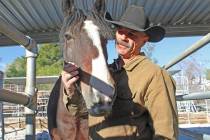Exercise eases pain of arthritis
Osteoarthritis is a disease process that affects the lives of more than 27 million Americans on a daily basis. Osteoarthritis is the most common form of joint deterioration, typically because of years of wear and tear on the joint.
The degeneration of the joint cartilage typically begins in the middle age years and progresses as people age, causing pain and stiffness in the joint. Although osteoarthritis can been found in any of the joints, it is mostly found in the “overused” joints such as hips, knees, shoulder, elbows, thumbs and neck. The pain and stiffness can be overwhelming to people as they get older. The pain associated with the arthritis can, for some, become socially crippling.
Cartilage is prevalent in all joints, and necessary for proper movement. Movement is generated by muscles. As muscles flex and relax they lift the bones that they are attached to pivoting at the bone joint.
For example, for the simple act of walking, persons must flex and relax all of the leg muscles and hip flexors, which lift and propel the femur, tibia and fibula. The joints affected by a simple act of walking are the ankles, knees and hips.
The cartilage is the “grease” of the joints. Healthy cartilage is slippery tissue that is attached at the ends of bones. Where two bones meet and pivot the cartilage acts as a slippery buffer to help absorb shock. In osteoarthritis, the cartilage has worn away exposing the bone. The bone then grinds and rubs against another bone causing extreme pain, stiffness and swelling. Over time the joint may lose its normal shape, and may have a reduced movement and motion.
The cause of osteoarthritis is unknown, though there are many contributing factors that lead to the wear and tear of the joints. Getting older and being overweight are the two most associated risks for developing arthritis. As people get older the cartilage begins to degenerate. The heavier people are over their target weight can contribute to the unnatural wear and tear to overused joints.
Sports injuries and stresses to joints from work-related use are also big factors leading to osteoarthritis. Joints not properly formed as well as genetic joint degeneration also are causes leading to arthritis, though they may not be as common.
Because of the high population of people affected by arthritis, the market for curing arthritis is vast. People of all cultures are open-minded to try just about anything to help cure themselves from this debilitating pain.
Some “off the wall” remedies vary from shark cartilage to copper to snake venom. Although people have varying results, it should be noted that none of these remedies is Food and Drug Administration approved to help reduce pain, stiffness or swelling.
There are some simple things that sufferers can do to help reduce the pain associated with osteoarthritis. Weight loss is considered the No. 1 tip for those who are dealing with the pain. A healthy and effective exercise routine has shown to help reduce the pain and stiffness as well.
It was thought that exercise would lead to further degeneration of the joint cartilage, however, active exercise can lead to weight loss and improved joint motion.
There are over-the-counter remedies aside from NSAIDS (nonsteroidal anti-inflammatory drugs), which can be unhealthy for your liver, such as glucosamine and topical creams. Glucosamine is an amino sugar that has been shown to help improve cartilage in the joints. Topical creams such as capsaicin have no remedy effect to the joint, however, it may offer a certain degree of relief of pain.
For people who are very severely affected by osteoarthritis, there are clinics and physicians that can offer relief. Acupuncture, chiropractic doctors and physical therapy all have their own benefits for relieving certain types of unbearable and weakening arthritis.
For those people living a life affected by osteoarthritis, I encourage them to try one or more of these remedies. People should never feel prisoner to their own body because of joint pain. Take action now to help reclaim life.
If you have any other questions, please feel free to contact me at the fire house at 702-293-9228, or email me at bshea@bcnv.org.
Brian Shea is a Boulder City paramedic/firefighter.











